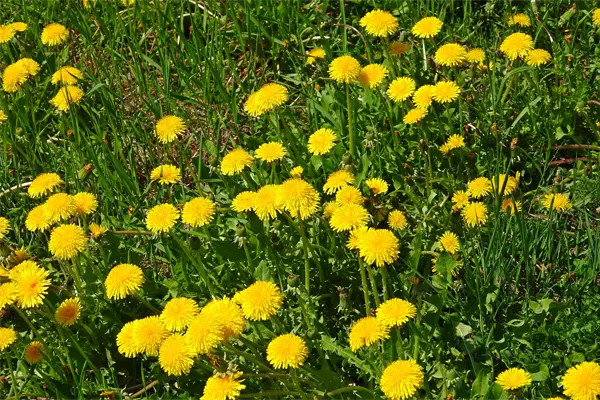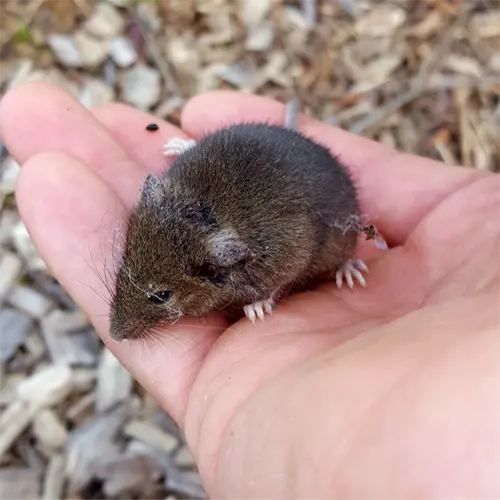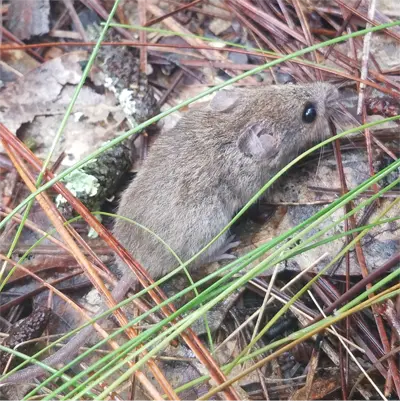Eastern Harvest Mouse
- Scientific Name
- Reithrodontomys humulis
- Also Known As
- Eastern Harvest Mouse
- Range
- Northern and Central Florida
- Diet
- Seeds, Weeds, Insects
- Life Expectancy
- 5 - 8 Months
Quick Links
Eastern Harvest Mouse in Central Florida
The eastern harvest mouse (Reithrodontomys humulis) is a small rodent species found throughout the southeastern United States, including central Florida.
Often overlooked due to its tiny size, the eastern harvest mouse plays an important ecological role as prey for raptors and snakes. This guide covers identification features, biology, habitat preferences, diet, health risks, and prevention tips for the eastern harvest mouse in central Florida.
Appearance and Identification
The Eastern Harvest Mouse can be identified by the following juvenile and adult characteristics
Photo 71474099 (c) Joe Girgente, CC BY-NC
Adult Eastern Harvest Mice
Juvenile Eastern Harvest Mice
The eastern harvest mouse is distinguished from the similar western harvest mouse by its darker fur and more eastern range. It lacks the climbing adaptions of the white-footed mouse which has shorter limbs and tail.
Maturation Rate
Newborn eastern harvest mice weigh only 2-4 grams but grow rapidly. Their ears open by 3-4 days old and eyes by 5-6 days old. Fine gray fur grows in by 1 week old. They are weaned by 2 weeks of age.
By 3-4 weeks old, the young are completely independent and leave the nest. They reach full adult size by 5-6 weeks old. Reproductive maturity occurs between 6-8 weeks of age and first litters are produced by about 10 weeks old.
Habits and Behavior
The eastern harvest mouse is mainly nocturnal and solitary. It constructs woven nests of grasses and leaves on the ground or low in vegetation including grass clumps, shrubs, and vines. Runways through dense ground vegetation interconnect nest sites and feeding areas.
Eastern harvest mice are agile climbers but spend most of their time on the ground. Home range sizes average 0.1-0.2 hectares. They tend to forage relatively close to their nests. During the day, they remain hidden in nests or sheltered spots on the ground.
Reproduction and Lifespan
The breeding season for eastern harvest mice spans spring through fall with most litters born between May and October. Females produce 2-3 litters per year ranging from 2-8 young. Gestation takes 23-25 days. The young are born hairless, with ears and eyes closed.
Weaning begins around 2 weeks and the young leave the nest by 3 weeks old. Sexual maturity is reached by 6-8 weeks of age. Average lifespan in the wild is just 5-8 months, while captive mice may live over a year. High reproduction balances their short lifespans and vulnerability to predators.
Ideal Habitat and Range
The subtropical climate of central Florida provides ideal habitat for eastern harvest mice. Average temperatures range from the mid 60s°F (18°C) in winter to the low 80s°F (27°C) in summer. Rainfall averages 50-60 inches per year.
These conditions allow dense ground vegetation like grasses, vines and shrubs to flourish. Rural overgrown fields, forest edges, wetlands, and scrublands provide ample food and cover sources. The eastern harvest mouse thrives in grassy habitats with adequate moisture and cover.
Urbanization has reduced natural habitat but eastern harvest mice adapt readily to gardens, parks, vacant lots, and similar green spaces in central Florida towns and cities. Protecting natural buffers and planting native vegetation promotes populations in developed areas.
Diet and Feeding
Eastern harvest mice are omnivores, feeding on seeds, insects, and green vegetation. Seeds of grasses, sedges, and forbs make up a major part of the diet. Insects including grasshoppers, beetles, caterpillars, ants, and wasps are also consumed. Green leaves, shoots, and stems provide moisture.
Eastern harvest mice will climb into low shrubs and vines up to 2 meters high to reach seeds, fruits, and insects. But most foraging occurs on the ground among dense grasses and herbaceous plants. Food caches may be created in nests. The mice do not hibernate but remain active year-round.


Common Health Risks
The eastern harvest mouse is not a significant disease threat to humans. They help control tick and insect populations. But they may transmit:
Hantaviruses – shed in urine, feces, and saliva. Can cause hantavirus pulmonary syndrome in humans.
Lyme disease – mice help feed ticks that transmit Lyme bacteria.
Salmonellosis – fecal contamination of food may spread Salmonella bacteria.
Overall, the risk of disease transmission from eastern harvest mice is low. Avoiding contact and proper hygiene minimizes any potential public health concerns.
Preventing Florida Water Rat Infestation
As native wildlife, eastern harvest mice are not considered a nuisance. But substantial populations can damage gardens, crops, or stored foods inside sheds. Prevention involves:
- Sealing access points into homes, garages, or food storage buildings.
- Removing ground cover and brush against structures.
- Installing raised vegetable gardens with wire mesh fence below grade.
- Cleaning up spilled pet food, bird seed, and trash that may attract mice.
- Keeping grass mowed around buildings.
- Using snap traps or live traps if mice enter buildings. Rodenticides are not recommended.
Population reduction is rarely needed for this native species. Exclusion and removing food attractants provides adequate prevention.
Eastern Harvest Mouse in Central Florida – Conclusion
The eastern harvest mouse is a small, prolific rodent well adapted to Florida’s subtropical climate. While rarely causing issues, their affinity for ground cover near buildings means preventing structural access is prudent.
Overall, the eastern harvest mouse is an asset for controlling insects and providing raptor prey. Protecting natural habitat maintains balance between nature and development in central Florida. With coexistence and ecosystem-based solutions, the eastern harvest mouse can thrive alongside human residents.






